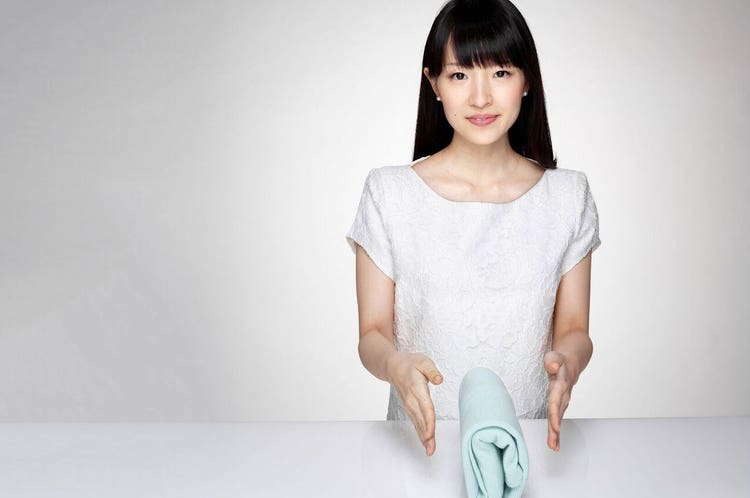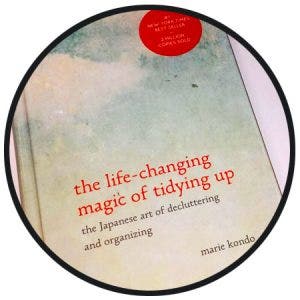Celebrate The Joy of Possessions

Celebrated organizing expert Marie Kondo doesn’t think you should get rid of everything.
Marie Kondo’s bestseller “The Life-Changing Magic of Tidying Up” does more than explore the virtues of being neat. Kondo creates a framework for joy that does not depend upon material possessions, and 24Life asked her for more insight into the part tidiness plays in one’s sense of well-being.
Kondo became interested in tidying when she was 5 years old. “I gathered as much information on tidying as I could, repeatedly practiced the principles I read about and spent my whole adolescence researching and studying the subject of tidying,” she explains. “When I was 19, I began my profession as an organizing consultant and gained clients as people began to share the positive effects my tidying method had on their lives.”
Kondo wrote her book when her client waiting list grew to six months long, and people requested it.

Marie Kondo (MK): I believe that the biggest reason why people accumulate so many things is that they never considered whether or not their possessions are important to them. Once they commit to making their lives feel lighter and begin the tidying process, they will realize that letting go of possessions isn’t as difficult as they imagined.
24Life: People often feel shame about the “untidiness” of their homes. Where do you think this feeling of shame comes from?
MK: This feeling of embarrassment stems from the fear that if our homes are cluttered, people might assume that our lives and personalities are also cluttered (even if this is untrue).
24Life: Your first rule when deciding if something should stay is to ask, “Does this spark joy?” What does this mean?
MK: “Does this spark joy?” is really asking whether the item brings joy to your life or not. The question is used to reconsider whether possessing a certain item makes you happy. It means, “Will I become happy by possessing this item?” The question frames the decision-making process in positive terms and is future-oriented.
24Life: Describe how you perceive things to have energy.
MK: Things have the ability to make us feel happy, to give us energy and to be useful in our lives. Because our lives are influenced by things, as well as human relationships, I believe that things have an energy all to themselves.
It is important to feel the item for yourself. Try holding things from the same category in your hands and compare them to one another. You can feel your body awaken or become heavy, reacting differently depending on the item that you hold in your hand.
24Life: How does decluttering our homes and the places we inhabit help us to feel better about ourselves and our lives?
MK: After you finish the substantial task of tidying, you will feel a sense of accomplishment and gain confidence in your decision-making abilities. Also, by living in a beautifully organized atmosphere every day, your self-image will improve.
24Life: You have said that your dream is to organize the world and that joy is the only goal – what do you mean by that?
MK: Once you finish tidying and are surrounded by things that are really important to you, you feel content and treat the things and the people around you with greater gentleness. If more people began to feel this way, I believe that we would be able to make a more peaceful world.
24Life: You typically start your tidying sessions by greeting the room and thanking the items. And when you return to your own home at the end of the day, you spray a fragrance to signify that your day is done. Why are these practices important to you?
MK: We are protected by our house and supported by our things each day. They contribute to our happiness. Therefore, giving thanks to these things is very natural for me.
24Life: Can you provide our readers with any advice to get started tidying and to stay committed to finishing?
MK: It helps to tell someone close to you that you have begun the tidying process, and also to join a tidying community, which can involve your friends and family.
24Life: Can you advise us on making decisions about bringing new things into the home?
MK: Bringing new things into the home involves the same process as tidying — it requires asking yourself, “Does this spark joy?” Welcome only the items that generate a “yes” into your home.
24Life: Can your methodology apply to our productivity as well? Can we use it to decide what we should have on our daily to-do lists?
MK: After practicing the KonMari Method and making it a habit [to ask] yourself, “Does this spark joy?” even your to-do list will be based on the same criterion. You will ask yourself, “Should I really do this task?” By considering these questions, your activities will be selected carefully and lead to productivity.
Marie Kondo believes that everyone should be free of anything in their home or their life that doesn’t spark joy. She also believes that by making an event of it and jumping in to tidy up all at once, you can dramatically change your life. Here’s how to get started.
PAINT AN INNER VISION
Before you jump in, sit still and visualize how it will look and feel when you are finished — be specific about what a clutter-free life feels like for you. And what does joy — that feeling of happiness and energy — feel like for you? This is important to know, so that you can recognize it throughout your process, especially when it starts to feel like work. Kondo explains in her book that joy feels like a lightness in your body or a quickening of energy.
CALL FORTH THE STUFF
Yes, to tidy up, first make a big mess. Put everything in big piles in the center of the room. Everything. Do not edit during this process, just collect and put like items with like items, such as a pile of clothes, your pile of bathroom accessories, books and so on. Prepare to be overwhelmed and maybe shocked at how much you have; don’t judge, just notice. At the end of the process, it is typical to have one quarter of the stuff you had when you began.
CREATE A GOODBYE PILE
Touch everything with your hands, and notice how you feel about it. Be quick, but be clear that you are not having a dialogue about why it might be important to you. Just feel it, and if it has no energy except for the conversation of sentimentality and obligation in your mind, then thank it and say goodbye. This is not about being brutal and getting rid of everything just to have less, but about letting go of that which does not lift your spirits anymore.
BE STRATEGIC
Don’t start with the photos. You will get stuck. Kondo has a method to her tidying up that creates flow and ease in the process. Begin with clothing, then progress in this order: books, papers, miscellaneous items — and then move on to the most sentimental items.
BE CLEAR
Don’t be sneaky. It is easy to talk yourself into keeping something, so keep your criteria clear. If it doesn’t give you joy right now, let it go. Don’t save it for a rainy day. Don’t give it to your kids or your sisters, let it move on and out of your life.
BE TIDY
Now that you have sorted and are only keeping what sparks joy, it is time to put things back in a thoughtful way. Instead of hanging clothes, fold them the Kondo way. (The basic KonMari vertical fold can be applied to everything, claims Kondo. Start by making a long rectangle, and then fold the bottom to the top to create a little package — google “fold like Kondo” for hundreds of how-to videos). Organize like items with like items, with aesthetics in mind. Put things away every day and don’t allow them to get stuffed in out-of-sight containers. Heads up, the miscellaneous category is the most challenging to address. Keep counters clear and free and plan to live happy, free and full of joy.
About Marie Kondo
Marie Kondo is the founder of the KonMari Method and the author of “The Life-Changing Magic of Tidying Up.” Her book is a bestseller in the United States, Germany and the U.K. She has been featured in The London Times, The Wall Street Journal and Time and has recently been featured on Fortune’s 2016 “40 Under 40.”